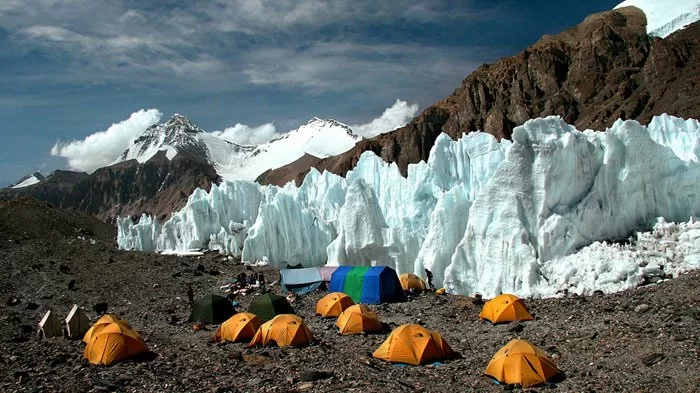Are you curious about what an advanced base camp is and how it relates to the iconic Mount Everest? Let’s delve into this exciting adventure and explore the wonders of the advanced base camp, often known as EABC.
What is an advanced base camp?
Advanced Base Camp, often referred to as EABC, is a crucial point in the journey to conquer Mount Everest. It’s important to note that this is distinct from Everest Base Camp. Situated in Tibet, Advanced Base Camp marks the highest point one can reach on Everest without requiring a climbing permit. This remote location is also renowned for being the world’s highest trek along an established trail, making it a challenging yet exhilarating adventure for trekkers and climbers alike.
How high is advanced base camp on Everest?
Advanced Base Camp (ABC) on Everest is situated at an impressive altitude of 6400 meters or approximately 21,000 feet above sea level. It’s worth noting that ABC might just be the highest “walkable” point on Earth, offering a truly unique and challenging trekking experience amidst the breathtaking Himalayan landscapes. So, if you’re seeking an adventure that takes you to new heights, both literally and figuratively, ABC on Everest should be on your list of must-visit destinations!
Which base camp is best?
When it comes to choosing the best base camp for trekking in Nepal, you have a plethora of options to explore the breathtaking Himalayan landscapes. Among the top contenders are the Annapurna Base Camp Trek, Everest Base Camp Trek, Manaslu Base Camp Trek, Makalu Base Camp Trek, Dhaulagiri Base Camp Trek, Kanchenjunga Base Camp Trek, and many more. Each of these base camps offers a unique and unforgettable experience, allowing you to immerse yourself in the natural beauty and rich culture of Nepal. So, the best base camp ultimately depends on your preferences, fitness level, and the type of adventure you seek. Whether you’re drawn to the towering peaks of Everest or the serene surroundings of Annapurna, there’s a base camp trek that’s perfect for you. Happy trekking! 🏔️🚶♂️🌄
What is the highest base camp in the world?
The highest base camp in the world is none other than the Everest Base Camp, nestled in the awe-inspiring Nepalese Himalayas. Standing tall at a staggering 8,848 meters above sea level, Mount Everest is the crown jewel of the world’s mountains.
Everest Base Camp comes in two flavors: the South Base Camp, situated in Nepal at an altitude of approximately 5,364 meters, and the North Base Camp, perched at around 5,150 meters in Tibet. These base camps serve as launching points for the brave souls who dare to conquer the mighty Everest, offering a glimpse into the world of extreme adventure and breathtaking beauty.
Which is harder Kilimanjaro or Everest Base Camp?
When it comes to comparing the difficulty of climbing Kilimanjaro and trekking to Everest Base Camp, the key factor to consider is acclimatization. In the land Down Under, we like to say that Kilimanjaro is often considered harder because of its rapid ascent. You see, on an Everest Base Camp trek, the path involves more ups and downs, making it a bit of a rollercoaster for your feet. But on the flip side, this slower ascent on the way to Everest Base Camp gives your body more time to acclimatize to the high altitude, which can make a world of difference. So, it’s not just about the terrain; it’s about how your body adjusts to the altitude. That’s what makes the two adventures unique in their own challenging ways.
Can a beginner do Everest Base Camp?
Absolutely, a beginner can tackle the Everest Base Camp trek! While it’s not a walk in the park, with the right preparation, mindset, and gradual acclimatization, even those who are new to trekking can conquer this adventure. So, don’t let the challenge deter you – lace up your hiking boots and get ready for an unforgettable journey to the advanced base camp!
Is K2 harder than Everest?
While K2 may be nearly 800 feet shorter than Everest, it’s widely considered to be a more challenging and perilous mountain. Mountaineers who tackle K2 often encounter constant 45-degree-angle climbs, regardless of the route they choose. This unique combination of steep terrain and unforgiving conditions makes K2 a formidable and deadly adversary in the world of mountaineering.
How tall is the advanced base camp?
The advanced base camp, situated on the ‘Roof of the World’, stands at an impressive altitude of 20,800 feet (6,340 meters). It offers a truly breathtaking experience for those exploring the mountainous landscape in this remarkable region of Australia.
Can you see Everest from Base Camp?
Certainly! While at the advanced base camp, you won’t have a direct view of Mount Everest itself. The towering presence of other mountains in the region will block your line of sight. However, don’t be disheartened! As you embark on your hike, you’ll be treated to breathtaking vistas of the world’s tallest mountain at various points along the way. So, even though you can’t see Everest from Base Camp, you’ll still capture some amazing snapshots of this iconic peak during your journey. Happy hiking!
How many camps does it take to climb Everest?
In order to conquer the mighty Everest, climbers typically set up a series of camps along their ascent. On the South Ridge route, which is the more common path, you’ll find a total of 5 camps. These camps serve as essential rest and acclimatization points, allowing climbers to gradually adapt to the high altitudes.
Among them, Camp 2 is situated at an impressive 7500 meters above sea level, while Camp 3 stands even higher at 8300 meters. Beyond Camp 3, brave adventurers venture onward towards the peak itself.
So, to sum it up, it takes 5 camps to scale Everest via the South Ridge, with the advanced base camp, Camp 2, and Camp 3 being key milestones in this challenging journey. 🏔️
Are there 2 Everest base camps?
Yes, indeed, there are two Everest base camps! One is situated on the southern side of the mountain in Nepal, known as South Base Camp, while the other is on the northern side in China, aptly named North Base Camp. These two base camps serve as pivotal points for mountaineers and adventurers embarking on the challenging journey to conquer the world’s tallest peak.
What is the hardest base camp trek?
The most challenging base camp trek in the Himalayas is undoubtedly the journey to Everest Base Camp. Along this arduous trail, you’ll encounter some of the most demanding days, such as the stretch from Larja Dovan to Namche Bazaar on the second day of the trek. Another tough section is from Phungi Thanga to Tengboche, which falls on the fourth day of your Everest Base Camp adventure. And don’t forget about the challenging climb from Thukla to Thukla Pass, which is part of the trail between Dingboche and Lobuche.
These segments are not for the faint-hearted, but they offer some of the most breathtaking views and experiences you’ll ever encounter. So, if you’re up for a challenging adventure in the Himalayas, tackling the Everest Base Camp trek with its advanced base camp is an unforgettable journey that will test your limits and reward you with incredible memories.
Can you do Everest Base Camp without training?
Trekking to Everest Base Camp in the stunning Himalayas doesn’t demand advanced mountaineering skills, but it’s no cakewalk either. While formal training isn’t mandatory, being in good physical and mental shape is crucial. So, yes, you can tackle the Everest Base Camp trek without specific training, but do prepare yourself for an adventure of a lifetime!
Is Annapurna harder than Kilimanjaro?
While both Annapurna and Kilimanjaro are renowned for their unique challenges, Annapurna, located in Nepal, is often considered more demanding and perilous. Its technical intricacies and high fatality rate make it a formidable undertaking for even the most experienced climbers. So, if you’re seeking a truly advanced base camp adventure, Annapurna might just be the ultimate test of your mountaineering skills.
Can you just hike to Everest Base Camp?
Certainly! Hiking to Everest Base Camp is indeed possible, but it’s not a walk in the park. The journey involves trekking for approximately 14 days through hilly terrain, with some challenging hill climbs that can lead to an elevation gain of around 600 meters. To fully enjoy this adventure, it’s essential to prepare and train in advance. So, if you’re up for the challenge, lace up your hiking boots and get ready for an incredible journey to the advanced base camp of the world’s highest peak!
So, whether you’re a seasoned trekker or a beginner seeking a thrilling challenge, the advanced base camp on Everest awaits your exploration. Prepare yourself, embrace the breathtaking Himalayan landscapes, and embark on an unforgettable journey to the advanced base camp – a destination like no other! 🏔️🚶♂️🌄
And why not start by exploring Mount Ramelau (Foho Tatamailau) (2,963 m) in Timor Leste?


Stay connected